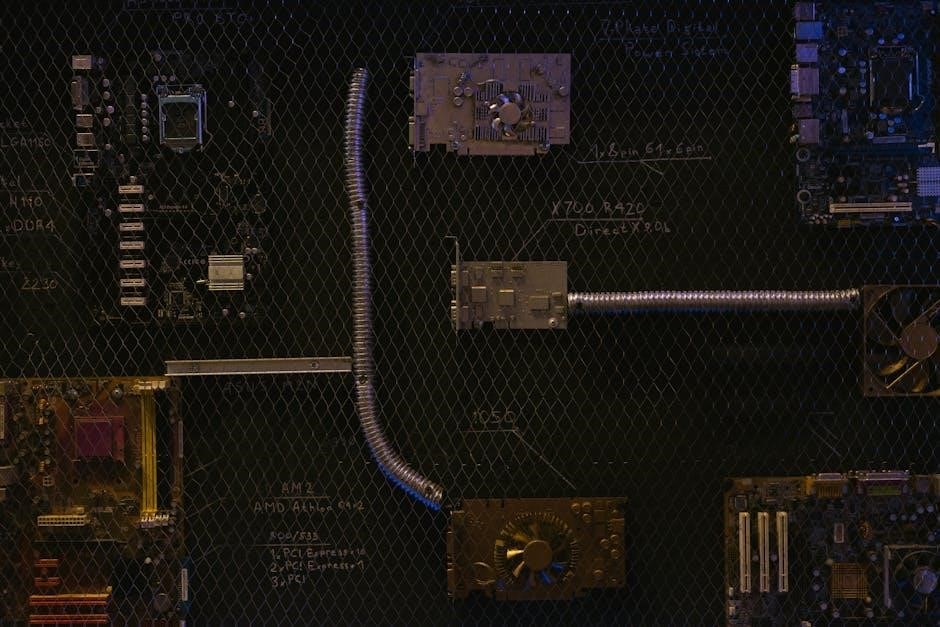The 2005 Ford F-150 wiring diagrams provide a comprehensive guide for understanding and repairing the truck’s electrical systems. Available as a downloadable PDF, these diagrams cover engine-specific connections, power distribution, and system integrations, making it easier to diagnose and fix electrical issues efficiently.

Engine-Specific Wiring Diagrams
The 2005 Ford F-150 wiring diagrams provide detailed schematics for engine-specific systems, including fuel injection, powertrain management, and charging systems. These diagrams cover the 4.6L V8 and 5.4L V8 engines, ensuring accurate connections and proper system functionality.

2.1. 4.6L V8 Engine Wiring Connections
The 4.6L V8 engine wiring connections in the 2005 Ford F-150 are critical for ensuring proper engine performance and functionality. This section of the wiring diagram focuses on the electrical pathways that power the engine’s core components, such as the Engine Control Module (ECM), fuel injectors, and ignition coils. The wiring harness for the 4.6L V8 is designed to handle the higher current demands of the eight-cylinder configuration, with dedicated circuits for the intake manifold, exhaust gas recirculation (EGR), and throttle position sensor.
Key connections include the battery and alternator, which supply power to the entire system, as well as the crankshaft and camshaft position sensors that ensure precise engine timing. The wiring diagram also details the coolant temperature sensor and mass airflow sensor connections, which are vital for accurate fuel injection and emissions control. Grounding points are clearly marked to prevent electrical interference and ensure reliable operation.
Understanding these connections is essential for troubleshooting issues like rough idling, misfires, or failed emissions tests. The diagram provides a clear, color-coded layout to help technicians and DIYers identify and repair wiring faults efficiently.
2.2. 4.6L V8 Powertrain Management System
The 4.6L V8 Powertrain Management System in the 2005 Ford F-150 is a sophisticated network that integrates the engine and transmission to optimize performance, efficiency, and drivability. This system relies on advanced wiring connections to ensure seamless communication between components. The Engine Control Module (ECM) serves as the central hub, processing data from sensors like the throttle position sensor, crankshaft position sensor, and camshaft position sensor to regulate fuel injection, ignition timing, and emission controls.
The wiring diagram highlights the connections between the ECM and the Transmission Control Module (TCM), which work together to synchronize engine power delivery with transmission shifting. Additional components, such as the torque converter clutch solenoid and the electronic throttle body, are also integrated into this system. The diagram details the wiring routes for these components, including power supply lines, ground connections, and communication circuits.
By referencing the wiring diagram, technicians can diagnose issues like erratic shifting, poor acceleration, or reduced fuel efficiency. The color-coded layout and detailed annotations provide clarity, making it easier to trace faults in the powertrain management system.
2.3. 5.4L V8 Engine Wiring Connections
The 5.4L V8 engine wiring connections in the 2005 Ford F-150 are critical for ensuring proper communication between the engine control module (ECM) and various components. This engine features a three-valve design, and its wiring diagram outlines the connections for fuel injectors, ignition coils, and sensors such as the oxygen sensor, manifold absolute pressure (MAP) sensor, and coolant temperature sensor. These connections are essential for maintaining optimal engine performance and fuel efficiency.
The wiring diagram also details the power and ground circuits for the 5.4L V8, including the battery, starter motor, and alternator connections. Additionally, it highlights the wiring for the variable valve timing (VVT) system, which adjusts camshaft timing to improve power delivery and reduce emissions. The diagram provides clear annotations for each connector and circuit, making it easier to trace wiring paths for diagnostics or repairs.
Understanding the 5.4L V8 wiring connections is vital for troubleshooting issues like rough idling, poor acceleration, or failed emissions tests. The diagram’s color-coded layout and detailed schematics ensure technicians can identify and resolve electrical faults efficiently, whether repairing or upgrading the engine’s electrical system.
2.4. 5.4L V8 Fuel Pump Circuit Diagram
The 5.4L V8 fuel pump circuit diagram provides a detailed layout of the electrical connections and components involved in the fuel delivery system. This circuit is essential for ensuring the fuel pump operates correctly, supplying the necessary fuel pressure for engine combustion. The diagram illustrates the connections between the fuel pump relay, fuel pump driver module, and the powertrain control module (PCM).
The circuit includes the fuel pump motor, fuel pressure sensor, and the wiring harness that connects these components to the vehicle’s electrical system. The fuel pump relay is activated by the PCM when the ignition is turned on or during engine operation, ensuring fuel flow only when needed. The diagram also highlights the inertia switch, which shuts off the fuel pump in case of a collision or sudden impact to prevent fuel leakage.
Understanding the fuel pump circuit is crucial for diagnosing issues like low fuel pressure or failure to start. The diagram’s clear representation of fuses, wiring colors, and connector locations helps technicians identify and repair faults efficiently, ensuring reliable engine performance and fuel delivery.
2.5. 5.4L V8 Charging System Wiring
The 5.4L V8 charging system wiring diagram outlines the electrical connections for the alternator, battery, and associated components. This system is responsible for charging the battery and powering the vehicle’s electrical systems when the engine is running. The diagram shows how the alternator is connected to the battery via a positive cable and how it communicates with the vehicle’s powertrain control module (PCM) through a wiring harness.
The charging system includes the alternator, voltage regulator, battery sensor, and wiring connectors. The alternator is belt-driven and generates electricity to recharge the battery and supply power to the vehicle’s systems. The voltage regulator, often integrated into the alternator, ensures a stable voltage output to prevent overcharging. The wiring diagram also details the fuses and relays associated with the charging system, such as the alternator fuse and the battery junction box connections.
Understanding this diagram is essential for diagnosing issues like a dead battery, dimming lights, or a malfunctioning alternator. It helps technicians identify wiring faults, corroded connections, or failed components, ensuring the electrical system operates efficiently and reliably. Regular inspection of the charging system wiring can prevent unexpected failures and maintain optimal vehicle performance.
System Coverage
The 2005 Ford F-150 wiring diagram provides comprehensive coverage of all major electrical systems, ensuring a thorough understanding for maintenance and repairs. It spans from the power distribution system to individual circuits like ABS and air conditioning, ensuring reliability and efficient system operation.
3.1. Power Distribution System
The 2005 Ford F-150 wiring diagram provides detailed insights into the power distribution system, which is the backbone of the vehicle’s electrical architecture. This system ensures that power is efficiently distributed to various components, including lights, accessories, and essential control modules. The diagram highlights the location of the main fuse box, typically found under the hood and inside the passenger compartment, along with the specific fuses and relays responsible for different functions.
The power distribution system is designed to manage high-current applications, such as the alternator, starter motor, and fuel pump, by incorporating dedicated circuits and heavy-duty wiring. The wiring diagram illustrates how these components are interconnected, making it easier to diagnose issues like blown fuses or faulty relays. Additionally, it provides a clear visual representation of the battery and starter motor circuit, which are critical for the vehicle’s operation.
By understanding the power distribution system through the wiring diagram, technicians and DIY enthusiasts can identify potential bottlenecks or overloaded circuits. This information is essential for maintaining the electrical integrity of the vehicle and ensuring all systems function as intended. The diagram also serves as a guide for adding aftermarket accessories without compromising the existing electrical infrastructure.
3.2. Anti-Theft System Integration
The 2005 Ford F-150 wiring diagram provides a detailed overview of the anti-theft system integration, which is a critical component of the vehicle’s security features. This system, often referred to as the Passive Anti-Theft System (PATS), is designed to prevent unauthorized access and engine start-up. The wiring diagram outlines the connections between the ignition system, immobilizer, and key fob, showcasing how these components communicate to ensure vehicle security.
The diagram highlights the wiring routes for the anti-theft modules, including the Powertrain Control Module (PCM), the Keyless Entry Module, and the transponder ring located around the ignition cylinder. It also illustrates the electrical pathways for the alarm system, which includes door and hood switches, the horn, and the siren. By referencing this section, technicians can diagnose issues such as failed key synchronization or false alarm triggers.
Understanding the anti-theft system’s wiring is essential for maintaining the vehicle’s security and addressing any malfunctions. The diagram serves as a valuable resource for troubleshooting and ensures that modifications or repairs to the system are performed correctly, preventing potential immobilization issues.
3.3. Cruise Control Wiring
The 2005 Ford F-150 wiring diagram provides comprehensive details about the cruise control system, which enables drivers to maintain a set speed with ease. This section focuses on the electrical connections and components that make up the cruise control system. The wiring diagram illustrates the connections between the cruise control switches on the steering wheel, the cruise control module, and the vehicle’s powertrain system.
The diagram highlights the wiring routes for the cruise control system, including the brake pedal switch, accelerator pedal position sensor, and the vehicle speed sensor. These components work together to ensure the cruise control operates smoothly and safely. The wiring connections are color-coded in the diagram, making it easier to trace and identify specific wires during repairs or modifications.
Understanding the cruise control wiring is essential for diagnosing issues such as intermittent system operation or failure to engage. The diagram also provides insight into how the system interfaces with other vehicle systems, such as the Powertrain Control Module (PCM). This information is invaluable for technicians and DIY enthusiasts alike, ensuring accurate troubleshooting and maintenance of the cruise control feature.
3.4. Supplemental Restraints System
The 2005 Ford F-150 wiring diagram provides detailed information about the Supplemental Restraints System (SRS), which includes airbags, seatbelt pretensioners, and the control module. This section of the wiring diagram outlines the electrical connections necessary for the proper operation of the SRS. It illustrates the wiring pathways for the front and side airbags, as well as the wiring for the seatbelt pretensioners and the SRS control module.
The diagram also details the connections for the crash sensors, which detect impacts and trigger the deployment of airbags. The wiring connections for the SRS are color-coded in the diagram, making it easier to identify specific wires during repairs or diagnostics. The SRS wiring diagram also shows how the system communicates with the Powertrain Control Module (PCM) and other vehicle systems. Understanding this wiring is critical for diagnosing issues such as airbag warning lights or malfunctioning seatbelt pretensioners. Technicians and DIY enthusiasts can use this information to ensure the SRS operates safely and reliably, providing critical protection in the event of a collision. Proper repair procedures are essential to maintain the integrity of the system.
3.5. Air Conditioning Circuits
The 2005 Ford F-150 wiring diagram provides a comprehensive overview of the air conditioning (A/C) system’s electrical circuits. This section details the wiring connections for the A/C compressor, condenser fan, evaporator, and associated control modules. It outlines the power supply routes, ground wires, and signal wires that ensure proper system operation. The diagram also illustrates the integration of the A/C system with other vehicle systems, such as the engine control module and the instrument cluster.
- The wiring diagram shows the connections for the A/C compressor clutch, including the high and low-pressure switches that monitor system performance.
- It highlights the wiring for the A/C control panel, which manages user inputs for temperature, fan speed, and mode selection.
- The diagram also includes details about the blend door actuator, which directs air flow between the heater core and evaporator.
Understanding the A/C circuits is essential for diagnosing issues like insufficient cooling or erratic system behavior. Technicians can use the wiring diagram to trace faults, such as blown fuses, faulty relays, or damaged wiring. Proper repair ensures reliable A/C operation, enhancing driver and passenger comfort. Always refer to the diagram for accurate troubleshooting and maintenance.
3.6. Anti-Lock Brake System (ABS)
The 2005 Ford F-150 wiring diagram provides detailed insights into the Anti-Lock Brake System (ABS), which enhances vehicle stability and control during hard braking. This section outlines the electrical connections for the ABS components, including the control module, wheel speed sensors, and hydraulic pump. It also illustrates how the system integrates with other safety features, such as traction control and electronic stability systems.
- The wiring diagram highlights the connections for the ABS control module, which processes data from wheel speed sensors to prevent wheel lock-up.
- It shows the wiring for the front and rear wheel speed sensors, which provide critical data to the ABS module.
- The diagram also includes the electrical pathways for the ABS hydraulic pump and solenoid valves, which modulate brake pressure during ABS activation.
Understanding the ABS wiring is crucial for diagnosing issues like ABS light illumination or loss of system functionality. Technicians can use the diagram to identify faults in sensors, wiring, or the ABS module itself. Proper repair ensures optimal braking performance and safety on the road. Always consult the wiring diagram for accurate troubleshooting and maintenance of the ABS system.

How to Read and Use the Wiring Diagrams

Mastering the 2005 Ford F-150 wiring diagrams requires understanding electrical symbols and circuit pathways. Start by identifying components like relays, fuses, and connectors. Trace circuits systematically to diagnose or repair issues efficiently. Always refer to the legend for symbol interpretations to ensure accuracy.
- Begin by familiarizing yourself with the diagram’s layout and legend.
- Identify the specific circuit or system you’re working on.
- Use the color coding to trace wires and connections accurately.
By following these steps, you can effectively use the wiring diagrams to troubleshoot or modify your truck’s electrical systems with confidence.
4.1. Understanding Electrical Symbols
Electrical symbols are the foundation of interpreting the 2005 Ford F-150 wiring diagrams. These symbols represent components, connections, and functions within the vehicle’s electrical systems. Common symbols include batteries, fuses, relays, connectors, and ground points. Understanding these symbols is crucial for identifying circuits and diagnosing issues.
- A battery is often shown as two parallel lines with a plus (+) and minus (-) sign.
- Fuses are represented by a rectangular box with lines indicating the fuse element.
- Relays are depicted as coils with contact points, showing their normally open or closed states.
- Connectors are illustrated as plugs or sockets, indicating where wires connect.
- Ground symbols, often a downward-pointing arrow, show where circuits connect to the vehicle’s chassis.
By familiarizing yourself with these symbols, you can decipher the wiring diagrams more effectively. Always refer to the legend or key provided in the diagram for specific interpretations, as symbols may vary slightly between manufacturers.
Practicing with sample diagrams and cross-referencing symbols will enhance your ability to trace circuits and understand the flow of electricity. This skill is essential for troubleshooting, repairs, and modifications to your Ford F-150’s electrical systems.
4.2. Locating Components in the Diagram
Locating components in the 2005 Ford F-150 wiring diagram requires a systematic approach. The diagram is typically divided into sections, such as engine compartment, interior, and power distribution. Start by identifying the specific system or circuit you are working on, as this will help narrow down the area of focus.
- Look for a key or legend at the beginning of the document, which explains the symbols and abbreviations used.
- Use the table of contents or index to quickly find the relevant page or section.
- Components are often labeled with their function or part number, making them easier to identify.
- Trace wires by following their color coding, as indicated in the diagram.
- Pay attention to connector and terminal identifiers, as these are critical for accurate repairs.
By carefully reviewing the layout and referencing the provided indices, you can efficiently locate components and understand their connections. This step is essential for diagnosing issues or performing modifications to your Ford F-150’s electrical system.
Mastering this process will save time and reduce confusion when working with the wiring diagram.
4.3. Step-by-Step Installation Guide
Following the 2005 Ford F-150 wiring diagram requires a structured approach to ensure proper installation and functionality. Begin by gathering all necessary tools and components, referencing the diagram for specific parts and connectors.
- Start by disconnecting the battery to prevent electrical shocks or system activation during work.
- Identify the wiring harness and components outlined in the diagram, ensuring all connections match the schematic.
- Use the diagram to locate mounting points and routing paths for wires to maintain proper organization.
- Install new components such as sensors, relays, or fuses, ensuring they are securely connected to the correct terminals.
- Reconnect the battery and test each circuit systematically to verify proper operation.
- Double-check all connections for tightness and accuracy, referencing the diagram as needed.
By adhering to the step-by-step guide provided in the wiring diagram, you can ensure a successful installation and avoid potential electrical issues. Always consult the diagram for specific torque specifications and wiring color codes to maintain system integrity.

Downloading the 2005 Ford F-150 Wiring Diagram PDF
Downloading the 2005 Ford F-150 wiring diagram PDF is a straightforward process that provides access to detailed electrical schematics for your vehicle. This resource is essential for diagnosing and repairing electrical systems, ensuring accurate wiring connections, and performing modifications.
- Visit the official Ford Motor Company website or trusted automotive repair platforms to find the PDF.
- Search for “2005 Ford F-150 wiring diagram” to locate the specific document tailored to your vehicle’s make and model year.
- Download the PDF directly to your device for easy access and offline use.
- Use a PDF viewer like Adobe Acrobat to navigate and zoom in on complex diagrams for clarity.
Ensure the downloaded PDF is authentic and matches your vehicle’s specifications to avoid confusion. This diagram is a valuable tool for both DIY enthusiasts and professional mechanics, offering a comprehensive guide to the truck’s electrical systems.
By having the wiring diagram PDF, you can confidently tackle electrical repairs and upgrades, knowing you have precise information at your fingertips.

Common Electrical Modifications
Many 2005 Ford F-150 owners opt for electrical modifications to enhance functionality, performance, or aesthetics. These modifications often involve wiring changes, making the wiring diagram essential for safe and accurate installations. Common upgrades include adding aftermarket lighting, such as LED light bars or fog lights, which require proper wiring connections to ensure they function correctly with the truck’s electrical system.
- Installing an aftermarket stereo or sound system often involves rewiring the audio circuits to ensure compatibility and optimal performance.
- Upgrading to a high-performance alternator may be necessary to support additional electrical components like winches or auxiliary power outlets.
- Adding trailer wiring harnesses for towing requires precise connections to the vehicle’s electrical system to ensure safety and functionality.
- Modifying the interior lighting, such as adding ambient LED lights, involves tapping into existing wiring without causing system malfunctions.
Before attempting any modifications, consult the wiring diagram to identify the correct circuits and connections. This ensures that upgrades are done safely and efficiently, avoiding potential damage to the vehicle’s electrical systems.

Troubleshooting Common Electrical Issues
When dealing with electrical problems in your 2005 Ford F-150, the wiring diagram is an invaluable tool for diagnosing and resolving issues. Common electrical problems include blown fuses, faulty sensors, or malfunctioning wiring connectors. These issues can cause symptoms like dim or flickering lights, non-functional electrical accessories, or even a failure to start the engine.
- Blown Fuses: Check the fuse box locations (passenger side dash and underhood) using the wiring diagram to identify which fuse corresponds to the affected system. Replace blown fuses with the correct amp rating to avoid further damage.
- Short Circuits: Use a multimeter to test for voltage drops or unintended continuity in wiring. The wiring diagram helps trace circuits to pinpoint the source of the short.
- Faulty Sensors: Sensors like the crankshaft position sensor or oxygen sensor can cause engine performance issues. Refer to the wiring diagram to locate sensor connections and test for proper operation.
- Corrosion: Inspect connectors and terminals for corrosion or damage. Clean or replace them as needed to ensure proper electrical flow.
Always consult the wiring diagram before making repairs to ensure accurate diagnosis and safe modifications. A systematic approach, guided by the diagram, helps resolve electrical issues efficiently and prevents further complications.

Safety Precautions When Working with Wiring
Working with electrical systems in your 2005 Ford F-150 requires careful attention to safety to avoid injuries or damage. Always disconnect the battery before starting any wiring work to prevent short circuits or electrical shocks. Wear insulated gloves and safety goggles to protect yourself from potential electrical arcs or flying debris.
- Disconnect the Battery: Locate the negative (-) terminal and remove the cable to ensure the electrical system is inactive. This step is critical to prevent accidental power surges.
- Use Proper Tools: Utilize insulated tools to handle live wires or components. Avoid using bare metal tools, as they can conduct electricity and cause shocks.
- Work in a Well-Ventilated Area: Some electrical repairs may involve soldering or heating wires, which can release fumes. Ensure good airflow to avoid inhaling harmful vapors.
- Ground the Vehicle: If working on high-voltage systems, ground the vehicle to discharge static electricity, which can damage sensitive components.
- Follow the Wiring Diagram: Use the 2005 Ford F-150 wiring diagram to understand the circuit layout and avoid unintentional connections that could cause system malfunctions.
Never skip safety steps, even for minor repairs. Electrical systems can be unpredictable, and negligence may result in serious harm or costly damage. If unsure, consult a professional or refer to the wiring diagram for guidance.

Structure of the Wiring Diagram PDF
The 2005 Ford F-150 wiring diagram PDF is organized into clear sections for easy navigation. It begins with a table of contents that lists all the major systems and subsystems covered, such as engine wiring, power distribution, and safety systems. Each section is further divided into detailed diagrams and charts.
The PDF typically includes a comprehensive index of electrical symbols and abbreviations used throughout the document. This ensures that users can interpret the diagrams accurately. The main body of the PDF is divided into engine-specific wiring diagrams, such as those for the 4.6L and 5.4L V8 engines, as well as system-wide diagrams for features like the anti-theft system and cruise control.
Additional sections cover troubleshooting guides and step-by-step repair instructions. The PDF also includes technical specifications, such as fuse box locations, wire color codes, and circuit descriptions. This structured format allows users to quickly locate the information they need without sifting through unrelated content. The clear layout ensures that even complex systems are presented in an accessible manner.
Finally, the document often concludes with manufacturer notes and disclaimers to ensure safe and accurate repairs. This organized structure makes the 2005 Ford F-150 wiring diagram PDF an indispensable resource for DIY enthusiasts and professionals alike.
